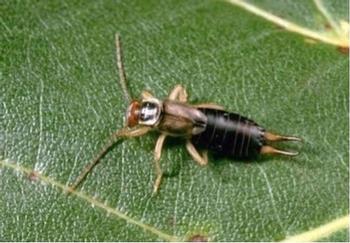Earwig
-
AboutEarwigs can devastate seedling vegetables or annual flowers and often seriously damage maturing soft fruit or corn silks. They also have a beneficial role in the landscape and have been shown to be important predators of aphids. Although several species occur, the most common in California gardens is the European earwig.
 Photo: Courtesy of UCIPM
Photo: Courtesy of UCIPM -
CategoryInsect
-
Signs/Symptoms
European earwigs feed on a variety of dead and living organisms, including insects, mites, and growing shoots of plants. They are voracious feeders on soft-bodied insects such as aphids and insect eggs and can exert significant biological control under some circumstances.
European earwigs can cause substantial damage to seedling plants and soft fruit as well as sweet corn. Damaged seedlings may be missing all or parts of their leaves and stem. Leaves on older plants, including fruit trees, have numerous irregular holes or are chewed around the edges. This damage may resemble that caused by caterpillars. Look for webbing, frass (excrement), or pupae that would indicate the presence of caterpillars.
Earwigs may attack soft fruit such as apricots, strawberries, raspberries, or blackberries but don’t harm hard fruit such as apples. On stone fruit, look for shallow gouges or holes that extend deeply into the fruit. On strawberries, distinguish earwig damage from that of snails and slugs by checking for the slime trails snails and slugs leave behind. On corn, earwigs feed on silks and prevent pollination, causing poor kernel development. Earwigs may also seriously damage flowers including zinnias, marigolds, and dahlias. To confirm that earwigs are causing the damage, go out at night with a flashlight to observe the pests in action.
-
Where
Earwigs seek out dark, cool, moist places to hide during the day. Common hiding places are under loose clods of soil, boards, or dense growth of vines or weeds or even within fruit damaged by other pests such as snails, birds, or cutworms.
-
When
Earwigs feed most actively at night.
Part of the earwig population hibernates during the winter as pairs buried in cells in the soil. In the hotter parts of California, earwigs may be relatively inactive during the summer. In milder California climates, some remain active all year.
-
Prevent
Reduce outdoor hiding places:
Eliminate dense undergrowth of vines, ground cover, and weeds around vegetable and flower gardens.
Prune away fruit tree suckers.
Remove leaves, boards, boxes, trash, and other debris from planting areas.
Move flower pots and other garden objects and structures that can harbor earwigs.
Check plastic or organic mulches and remove them to limit earwig numbers.
-
Manage
As moisture-loving insects, earwigs wouldn’t normally thrive in California’s arid climate without the moisture and shade provided by irrigated gardens. Where earwigs are a problem, consider reducing hiding places and surface moisture levels. Initiate a regular trapping program. If these measures are followed, insecticide treatments shouldn’t be necessary. Baits are available for earwigs but often aren’t very effective. Keep in mind that earwigs are omnivores and are beneficial in some situations, such as when they feed on aphids, and don’t need to be managed in many situations.
Trap earwigs with rolled newspaper, bamboo tubes, or short pieces of hose. Place these traps on the soil near plants just before dark, and shake accumulated earwigs into a pail of soapy water in the morning.
Fill a low-sided can with vegetable oil and a drop of bacon grease or fish oil to attract and trap earwigs.
Daily trapping will reduce earwig populations to tolerable levels.
Drip irrigate where possible to reduce surface moisture.
Keep earwigs out of stone fruit trees with a band of sticky substance such as Tanglefoot around the trunk, and harvest fruit as soon as it ripens.
Insecticides should rarely be needed.
Earwigs might seek refuge indoors when conditions outside are too dry, too hot, or too cold. Large numbers of earwigs can be annoying, but present no health hazard. If earwigs invade your home, follow these steps:
Sweep up or vacuum invading earwigs.
Seal cracks or other entry points.
Remove debris from gutters and around entryways.
Keep water and moisture away from structures.
Replace white outdoor lights with yellow ones, which are less attractive to earwigs.
Indoor applications of pesticides aren’t recommended.
-
More Information
Due to their small size, earwigs have a number of natural predators. Amphibians such as frogs, newts and toads are among the most common predators of the earwig along with birds and other larger insects such as beetles.

